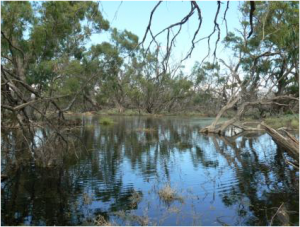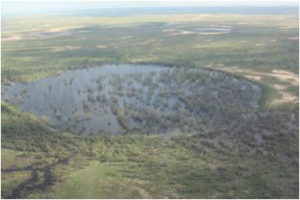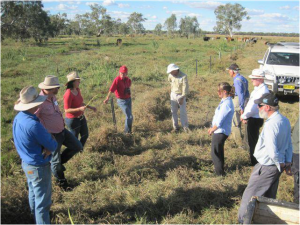
WETLAND WATERING
Annual Environmental Watering Plan
 The Lachlan River Working Group has submitted the 2011/12 Annual Environmental Watering Plan for the Lachlan. This Plan lists options and priorities for environmental water in the 2011/12 water year. Options and priorities are determined by a number of factors including available water, time since last watering ecological need and ability to deliver. As indicated in Table 1, environmental accounts will have over 100,000 ML available for use in 2011/12. One option is to hold some of this water over for future years to ensure targeted wetlands can be inundated over a prolonged period.
The Lachlan River Working Group has submitted the 2011/12 Annual Environmental Watering Plan for the Lachlan. This Plan lists options and priorities for environmental water in the 2011/12 water year. Options and priorities are determined by a number of factors including available water, time since last watering ecological need and ability to deliver. As indicated in Table 1, environmental accounts will have over 100,000 ML available for use in 2011/12. One option is to hold some of this water over for future years to ensure targeted wetlands can be inundated over a prolonged period.
Another option includes Muggabah Creek as the associated Lower Gum Swamp, is considered in being in a critical condition and could be assisted by receiving follow-up watering. Other options include, Lachlan Swamp and Morrison’s Lake, which could also benefit from further watering.
The 2011/12 Lachlan Annual Environmental Watering Plan is available to view at www.LRWG.com.au
Proposed June Water
To complement 2010/11 watering events, further environmental water was delivered to Merrowie Creek and Merrimajeel Creek. Targets for this water included Cuba Dam on Merrowie Creek and Murrumbidgil/ Lake Merrimajeel on Merrimajeel Creek. This watering action was undertaken to continue supporting river red gum recovery and other water dependent species following such a prolonged drying period.
Tarwong Lake
As a result of local rainfall and runoff and environmental water delivery to Merrowie Creek in 2010/11, Tarwong Lake became inundated after a decade of drought. Tarwong Lake is a series of shallow depressions fringed by river red gums and lignum. When in flood it forms a valuable waterbird habitat and supports freckled and blue-billed ducks, and glossy ibis. Black box, canegrass and bladder saltbush also occur in the area. The Lake has now been inundated for a number of months and associated wetland vegetation has responded well to watering.
LACHLAN RIVERINE WORKING GROUP WEBSITE
The LRWG have developed a website to keep interested people informed of environmental watering activities and outcomes. The website also provides a lot of background information from which the watering decisions have been derived. The website can be found at www.LRWG.com.au
Table 1 Volumes of environmental water available 2011-12
|
Account |
Maximum limit (ML) |
Available (ML) 1/7/11 |
|
Translucent dam |
350,000 |
Rules- based ( subject to inflows of 250,000 ML being received in calendar 2011) |
|
Environmental Contingency Allowance |
20,000 |
20,000 |
|
Water Quality Allowance |
20,000 |
20,000 |
| RiverBank | 25,575 (1,000 share units of HS and 24,575 share units of GS registered at July 2011) | 1000ML of HS and 24,575ML (Only 100% of GS entitlement can be used this water year although account holdings will be greater than 100%) |
| Commonwealth Holdings | 82,726 (733 share units of HS and 82,709 share units of GS registered at July 2011) | 733ML of HS and 82,709ML of GS (Only 100% of GS entitlement can be used this water year although account holdings will be greater than 100%) |
| Lake Brewster Adaptive Environmental Water Licence | 12,000 (GS) | 12,000ML (Only 100% of GS entitlement can be used this water year although account holdings will be greater than 100%) |
PROJECT UPDATE
Working Wetlands
As part of the LCMA ‘Working Wetlands’ program, which aims to provide assistance to landholders managing Nationally Significant wetlands, targeted properties across the lower Lachlan recently received a boost from an aerial feral pig cull, conducted by the Riverina Livestock Health and Pest Authority (LHPA), with assistance from the National Parks and Wildlife Service and the Western LHPA.
Over the five day shoot, 368 feral pigs were destroyed across the area. It is hoped the timing of the shoot will add to its success as many of the pigs were ready to breed. This aerial cull is just the first step in an ongoing attempt to keep feral pig numbers down in these vulnerable habitats, with some properties set to receive pig traps to assist in further controlling pig numbers.

Macquarie Marshes grazing management practices being observed by Lachlan ‘Working Wetlands’ participants
As part of another activity undertaken as part of the ‘Working Wetlands’ project, representatives from four properties in the Nationally Significant Booligal Wetlands enjoyed a three day field trip to the Macquarie Marshes. This trip was hosted by the LCMA, and supported by the NSW Office of Environment and Heritage and the Central West CMA. The LCMA saw it as an opportunity for Booligal landholders to discuss, see and share a variety of management practices and techniques being used in other wetlands. Attendees also formed networks with landholders in a different geographical area who face similar challenges in wetland management in a productive landscape.
